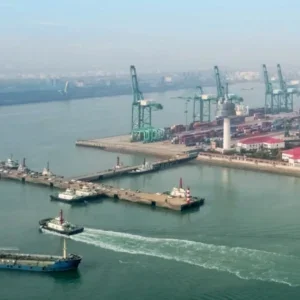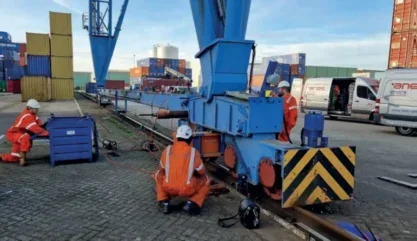
Nedcranes, a specialist for port, overhead and gantry cranes based in the Netherlands, has partnered with motion drives manufacturer, WEG to modernise an overhead crane system at Rail Port Brabant in Tilburg, Netherlands. WEG’s expertise in custom engineering, plus its W22 line of electric motors, has achieved sustainability and noise reduction at the port.
Cranes are often used in demanding environments where they must withstand heavy loads, harsh weather conditions and rigorous usage. Unsurprisingly, these operations can be energy intensive. Finding a balance between energy efficiency and environmental resilience involves selecting equipment that offers the necessary strength and durability.
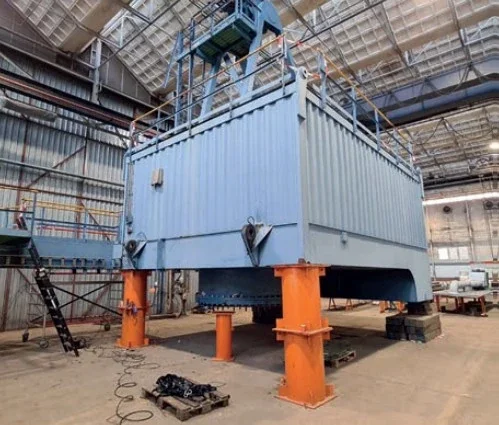
Nedcranes, which specialises in inspections and repairs to complete overhauls including maintenance of port cranes, was tasked with modernising an overhead crane system at the Rail Port Brabant rail terminal. The project would involve dismantling an old crane, adjusting its track width and beam length and turning its cat around.
A solution was devised that would involve replacing DC motors with variable frequency drive (VFD)-driven AC motors for enhanced efficiency and performance. Understanding the need to determine indicators such as speeds, transmission ratios, pole pairs, magnetisation currents and required braking power, Nedcranes invited WEG to be its partner and supplier of motors and drives.
A new hoisting solution was installed replacing DC motors with VFD driven alternating current (AC) motors. Replacing DC motors with VFD controlled AC motors offers several advantages, including improved energy efficiency, precise speed control, reduced maintenance needs and enhanced reliability.
By varying the speed of the motor, VFDs enable smoother operation and better performance while also allowing for more flexible and efficient power management.
After identifying the necessary loads, speeds and weather conditions such as wind and rain, WEG selected the most suitable motors from its portfolio.
In total, four 30 Kilowatts (kW) motors for crane movement, two 22 kW trolley motors, a 7.5 kW motor for the lifting device and a 170 kW motor for the winch were provided by WEG. All motors, except for the winch motor, were equipped with gearboxes, and mechanical brakes that are a standard safety requirement in the world of cranes.
All motors are from the WEG W22 series, with IE3 Premium Efficiency rating. The motors are also low noise, an important consideration since the Rail Port Brabant rail terminal is located near a residential area.
The ventilation system design of the W22 line provides lower noise levels and allows a better distribution of the air flow over the motor, which minimises hot spots on the surface and increases reliability.
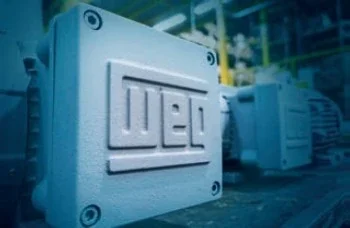
WEG W22 line reduces energy consumption, offers excellent cost effectiveness and greater productivity.
“In the crane market, you must find balance,” said Van Beijnen, senior project manager, Nedcranes. “Not only in terms of severity, energy, technology and costs, but also in terms of partners with whom you perform this type of large-scale projects. Fortunately, we found that in WEG solutions.”
The collaborative effort between WEG and Nedcranes stands as a testament to the power of innovation in addressing the challenges of the crane industry. By embracing cutting-edge technology and sustainable practices, the modernisation of the port’s overhead crane system enhances operational efficiency and reduces environmental impact.
In continuation of its fleet renewal programme initiated in 2021, A.P. Moller – Maersk (Maersk) is in the process of signing new building orders and time-charter contracts for dual-fuel vessels matching the planned renewal pace of around 160,000 TEU per year.
“Our fleet renewal program is fundamental to maintaining competitive edge in our ocean business, and it is a cornerstone in decarbonising our operations. As the shipyard orderbooks have been filling up quickly and lead time for vessel deliveries have increased significantly, we decided to place orders and charter contracts of 800,000 TEU (twenty-foot equivalent) dual-fuel vessels, which ensures a steady flow of needed capacity for our network for the years 2026- 2030 while building a competitive toolkit,” said Rabab Boulos, COO, Maersk.
The ordered capacity will be a mix of owned and chartered, ensuring Maersk maintains strong financial and operational flexibility while continuing to own a significant part of its strategic tonnage. The vessels come in different sizes offering network optionality. In line with Maersk’s commitment to decarbonisation, all vessels will be dual fuel with the intent to operate them on low emissions fuel.
To ensure the long-term competitiveness of the fleet and its ability to deliver on the decarbonisation goals, Maersk has elected a mix of methanol and liquified gas dual-fuel propulsion systems. While green methanol is likely to become the most competitive and scalable pathway to decarbonisation in the short term, Maersk also foresees a multifuel future for the industry which includes liquified bio-methane. Once the vessels have been delivered, around 25% of the Maersk fleet will be equipped with dual-fuel engines.
“These orders will not add to the overall capacity and over time every vessel coming in will be replacing a scrapped vessel having reached end of life, ensuring that we maintain our fleet size at around 4.3 million TEU. By diversifying our fleet and fuel options, we gain the flexibility, knowledge, and experience to cater to a future with multiple fuel paths. We thank our partners for working with us to move the industry further towards enabling a future with decarbonised ocean transport,” said Ahmed Hassan, head, Asset Strategy & Strategic Partnerships, Maersk
The orders will reach a total of 50-60 combining both owned and chartered dualfuel vessels equalling 800,000 TEU.
Approximately 300,000 TEU will be owned capacity while the remaining 500,000 TEU is planned through timecharter agreements.
The exact split of propulsion technologies will be determined considering the future regulatory framework and green fuels supply.
Maersk has commenced the work of securing offtake agreements for liquified bio-methane (bio-LNG) to ensure that the new dual-fuel gas vessels provide greenhouse gas emissions reductions in this decade.
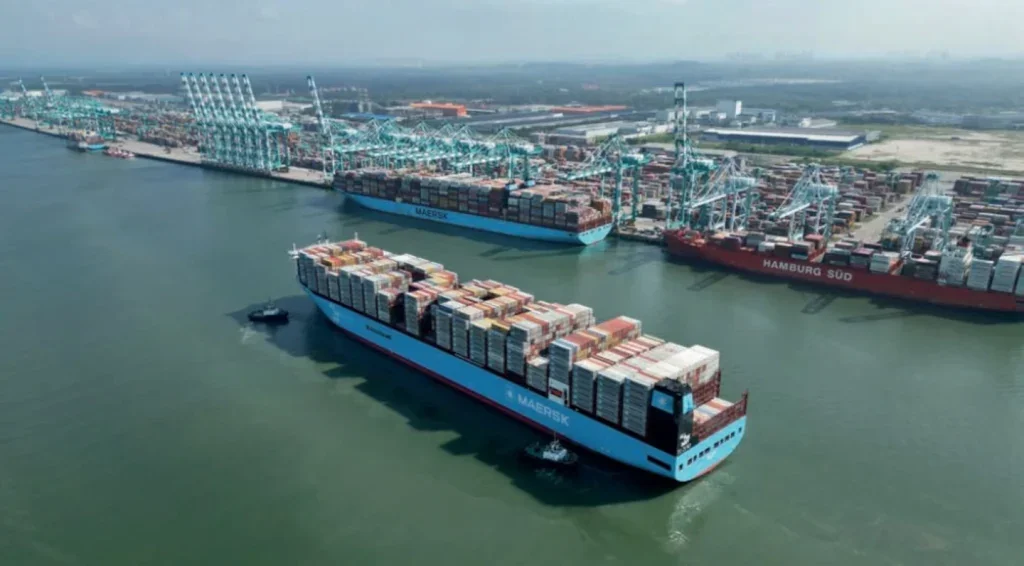
Maersk has previously announced the orders of 25 owned dual-fuel methanol vessels; five in service and 20 on order providing around 350,000 TEU of dual-fuel capacity.
Continuing the theme of green energy, Abu Dhabi-based Fertiglobe, a strategic partnership between ADNOC and OCI Global, has emerged as the winning bidder of the first H2Global pilot auction for renewable ammonia, funded by the German Federal Ministry for Economic Affairs and Climate Action (BMWK).
As the winning bidder, Fertiglobe will start producing renewable ammonia destined for delivery in European ports in 2027 for a maximum contract value of €397 million. The delivery will start at a potential 19,500 tons in 2027 (subject to actual production start date and supply availability), with volumes potentially scaling up to 397,000 tons cumulatively by 2033, at a delivered contract price of €1,000 per ton.
With this result, Europe has secured a significant supply of renewable ammonia and reached a significant milestone in the advancement of the European renewable ammonia market and global decarbonization efforts, said Hintco, an intermediary for purchasing and selling green power-to-X (PtX) products within the H2Global funding mechanism.
Germany will need to import around 50% to 70% of its green hydrogen due to limited renewable energy resources needed to produce it.
In addition, the pilot auction established the first price signal at a contract price of €1,000 per ton (including delivery to Europe) and a net price of €811 per ton for renewable ammonia, thereby taking the first step towards a global renewable ammonia market.
These price signals for renewable ammonia send a positive, clear, and strong message, indicating it can be produced and imported into the EU at attractive prices through targeted support to the most competitive projects, Hintco explained.
“This auction result is a strong indication of the market potential of renewable hydrogen and its derivatives. The energy transition requires value for money, workable solutions – and this first pilot auction has demonstrated that financial and procurement innovations like H2Global’s mechanism not only work but are needed to create thriving markets that motivate and mobilize private finance,” said Timo Bollerhey, CEO, Hintco and cocreator, H2Global.
The pilot auction for Lot 1 covering renewable ammonia was launched at the end of 2022, receiving interest from over 65 countries and bids from 22 companies/ consortia from five continents. Fertiglobe emerged as the successful bidder among five finalists.
Lots 2 and 3 covered renewable methanol and e-sustainable aviation fuel (eSAF) respectively, with the latter ending without a contract being awarded. As a result, the funds from eSAF will be allocated to the ongoing Lot 2 for renewable methanol.
The German government has committed €4.43bn to H2Global’s ‘double-auction’ mechanism implemented by Hintco to facilitate the rapid expansion of renewable hydrogen and derivative products.
It is seeking to expand the use of green hydrogen fuel – made from water using solar or wind power – to cut emissions from industrial sectors that are hard to electrify, such as steel and chemicals, and reduce dependency on fossil fuel imports.
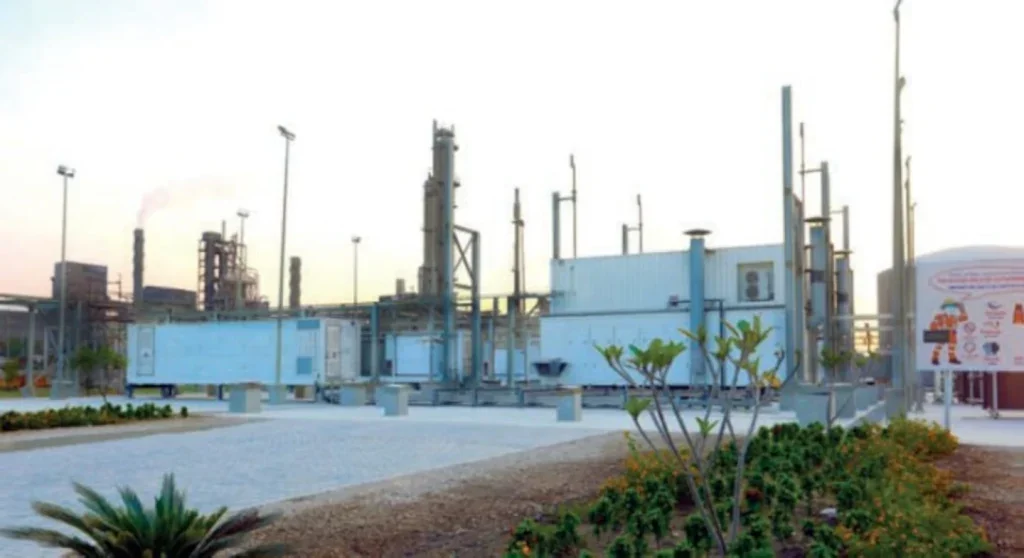
The ‘double-auction’ model, whereby buyers and sellers actively participate, will bridge the difference between high prices at which hydrogen is currently being traded on the global market, and lower prices at which it can be sold on and be used in economically viable ways at regional level.
For this contract, Fertiglobe will procure the supply of renewable hydrogen from Egypt Green Hydrogen to be used as feedstock for the production of renewable ammonia at the company’s existing ammonia plant in Ain Sokhna.
Egypt Green Hydrogen, a consortium between Fertiglobe, Scatec ASA, Orascom Construction, The Sovereign Fund of Egypt, and the Egyptian Electricity Transmission Company, is located in the Suez Canal Economic Zone. During a recent Egypt- EU Investment Conferencee, Fertiglobe signed an ammonia sale agreement with its consortium partners in Egypt Green Hydrogen.
The renewable ammonia will be delivered to the port of Rotterdam and sold by Hintco as standardized quantities in annual auctions.
The company stated it was committed to producing ammonia in compliance with EU regulations for renewable hydrogen and meeting the additional environmental and sustainability requirements set out in the tender.
“This award marks a significant milestone for Fertiglobe in advancing sustainable ammonia production and a further critical step towards FID of Egypt Green Hydrogen, expected in H1 2025. Our selection as the winning bidder in H2Global’s pilot auction underscores our leadership in supplying low-carbon products and our commitment to shaping a more sustainable future, and I appreciate the work of our incredible team to make this award possible,” said Ahmed El-Hoshy, CEO, Fertiglobe.
“We are leveraging this vital program which makes our investment in sustainable ammonia economically viable, supporting critical decarbonization technology, while maintaining our disciplined growth strategy.”
In May 2024, Fertiglobe produced the world’s first certified bulk commercial shipment of low-carbon ammonia enabled bu carbon capture and storage (CCS), delivered by ADNOC to Japan’s Mitsui & Co. for use in clean power generation.
The UAE player is progressing with other low-carbon ammonia projects, including TA’ZIZ, the 1 million tons per annum (mtpa) low-carbon ammonia facility in Al Ruwais Industrial City, in partnership with TA’ZIZ, Mitsui & Co., and GS Energy Corporation.


